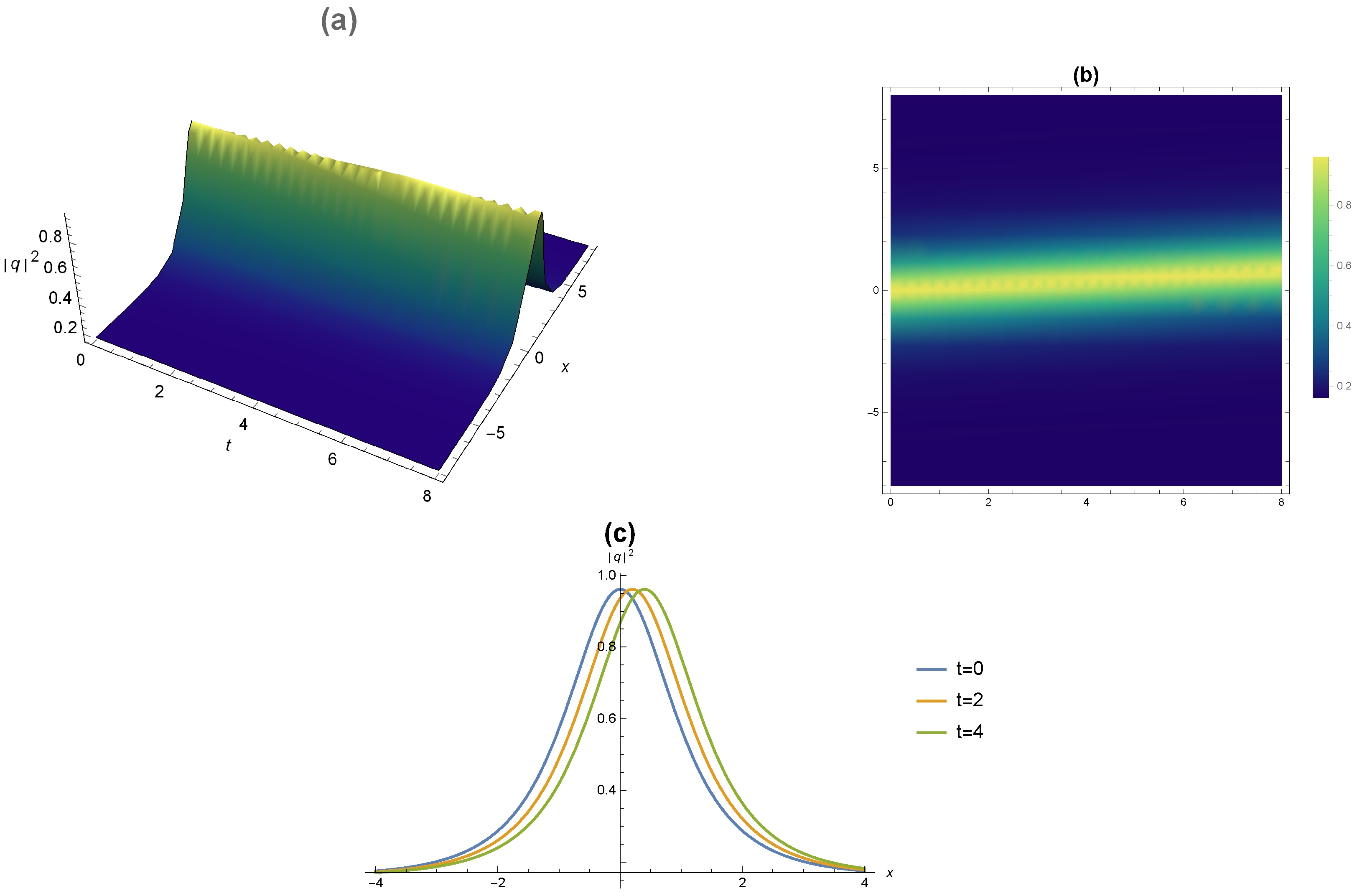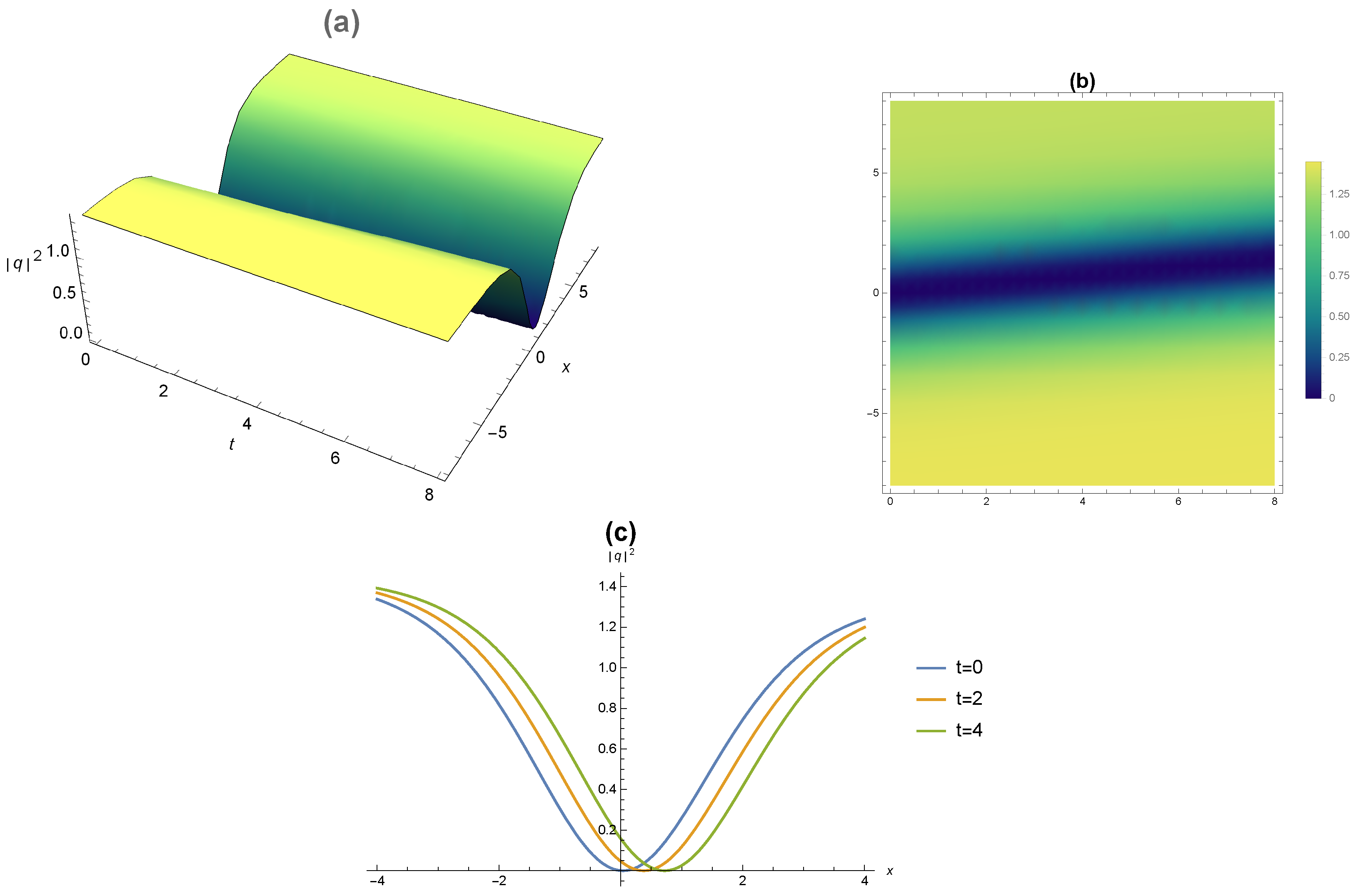Optical Solitons with the Complex Ginzburg–Landau Equation with Kudryashov’s Law of Refractive Index
Abstract
:1. Introduction
2. IMETF Procedure
- Step-1: Use a wave transformation
- Step-4: In Equation (4), substitute solution (5) together with (6). As a result, we obtain a polynomial of . We gather all terms of the same powers in the generated polynomial and equate them to zero to construct a system of algebraic equations that can be solved using Mathematica to identify the unknown parameters. and to obtain the solutions of Equation (2).
3. Soliton Solutions with CGL Model
- Case-1: Setting to get
- Case-2: Setting and to get
- Result-1
- Result-2
- Case-3: Setting and to get
- Result-1
- Result-2
- Case-4: Setting and to get
- Result-1
- Result-2
- Case-5: Setting and to get
- Case-6: Setting to get
4. Conclusions
Author Contributions
Funding
Institutional Review Board Statement
Informed Consent Statement
Data Availability Statement
Conflicts of Interest
Appendix A
Appendix B
References
- Gabitov, I.; Turitsyn, S. Averaged pulse dynamics in a cascaded transmission system with passive dispersion compensation. Opt. Lett. 1996, 21, 327–329. [Google Scholar] [CrossRef] [PubMed]
- Biswas, A.; Milovic, D.; Edwards, M.E. Mathematical Theory of Dispersion-Managed Optical Solitons; Springer: New York, NY, USA, 2010. [Google Scholar]
- Lenells, J.; Fokas, A.S. On a novel integrable generalization of the nonlinear Schrödinger equation. Nonlinearity 2008, 22, 11. [Google Scholar] [CrossRef]
- Ginzburg, V.L.; Landau, L.D. On the Theory of Superconductivity. Sov. Phys. JETP 1950, 20, 1064. [Google Scholar]
- Ginzburg, V.L.; Landau, L.D. On the Theory of Superconductivity, in on Superconductivity and Superfluidity: A Scientific Autobiography; Springer: Berlin, Germany, 2009; pp. 113–137. [Google Scholar]
- Kuramoto, Y. Chemical Oscillations, Waves and Turbulence; Springer Series in Synergetics; Springer: Berlin, Germany, 1984. [Google Scholar]
- Cross, M.C.; Hohenberg, P.C. Pattern formation outside of equilibrium. Rev. Mod. Phys. 1993, 65, 851. [Google Scholar] [CrossRef]
- Newell, A.C.; Passot, T.; Lega, J. Order Parameter Equations for Patterns. Annu. Rev. Fluid Mech. 1993, 25, 399–453. [Google Scholar] [CrossRef]
- Bohr, T.; Jensen, M.H.; Paladin, G.; Vulpiani, A. Dynamical Systems Approach to Turbulence; Cambridge University Press: Cambridge, UK, 1998. [Google Scholar]
- Biswas, A.; Kara, A.H.; Sun, Y.; Zhou, Q.; Yıldırım; Alshehri, H.M.; Belic, M.R. Conservation laws for pure-cubic optical solitons with complex Ginzburg–Landau equation having several refractive index structures. Results Phys. 2021, 31, 104901. [Google Scholar] [CrossRef]
- Das, A.; Biswas, A.; Ekici, M.; Zhou, Q.; Alshomrani, A.S.; Belic, M.R. Optical solitons with complex Ginzburg–Landau equation for two nonlinear forms using F-expansion. Chin. J. Phys. 2019, 61, 255–261. [Google Scholar] [CrossRef]
- Yıldırım; Biswas, A.; Khan, S.; Alshomrani, A.S.; Belic, M.R. Optical solitons with differential group delay for complex Ginzburg–Landau equation having Kerr and parabolic laws of refractive index. Optik 2020, 202, 163737. [Google Scholar] [CrossRef]
- Arshed, S.; Biswas, A.; Mallawi, F.; Belic, M.R. Optical solitons with complex Ginzburg–Landau equation having three nonlinear forms. Phys. Lett. A 2019, 383, 126026. [Google Scholar] [CrossRef]
- Biswas, A. Chirp-free bright optical solitons and conservation laws for complex Ginzburg-Landau equation with three nonlinear forms. Optik 2018, 174, 207–215. [Google Scholar] [CrossRef]
- Arnous, A.H.; Seadawy, A.R.; Alqahtani, R.T.; Biswas, A. Optical solitons with complex Ginzburg–Landau equation by modified simple equation method. Optik 2017, 144, 475–480. [Google Scholar] [CrossRef]
- Biswas, A.; Alqahtani, R.T. Optical soliton perturbation with complex Ginzburg-Landau equation by semi-inverse variational principle. Optik 2017, 147, 77–81. [Google Scholar] [CrossRef]
- Kudryashov, N.A. First integrals and general solution of the complex Ginzburg-Landau equation. Appl. Math. Comput. 2020, 386, 125407. [Google Scholar] [CrossRef]
- Kudryashov, N.A. A generalized model for description of propagation pulses in optical fiber. Optik 2019, 189, 42–52. [Google Scholar] [CrossRef]
- Arnous, A.H.; Biswas, A.; Yıldırım, Y.; Zhou, Q.; Liu, W.; Alshomrani, A.S.; Alshehri, H.M. Cubic–quartic optical soliton perturbation with complex Ginzburg–Landau equation by the enhanced Kudryashov’s method. Chaos Solitons Fractals 2022, 155, 111748. [Google Scholar] [CrossRef]
- Arnous, A.H.; Biswas, A.; Kara, A.H.; Milovic, D.; Yıldırım, Y.; Alshehri, H.M. Sequel to “cubic-quartic optical soliton perturbation with complex Ginzburg–Landau equation by the enhanced Kudryashov’s method”. IET Optoelectron. 2022, 16, 149–159. [Google Scholar] [CrossRef]
- Zayed, E.M.E.; Gepreel, K.A.; El-Horbaty, M.; Biswas, A.; Yıldırım, Y.; Alshehri, H.M. Highly dispersive optical solitons with complex Ginzburg–Landau equation having six nonlinear forms. Mathematics 2021, 9, 3270. [Google Scholar] [CrossRef]
- Abdou, M.A.; Soliman, A.A.; Biswas, A.s.; Ekici, M.; Zhou, Q.; Moshokoa, S.P. Dark-singular combo optical solitons with fractional complex Ginzburg–Landau equation. Optik 2018, 171, 463–467. [Google Scholar] [CrossRef]
- Samir, I.; Badra, N.; Ahmed, H.M.; Arnous, A.H. Solitons in birefringent fibers for CGL equation with Hamiltonian perturbations and Kerr law nonlinearity using modified extended direct algebraic method. Commun. Nonlinear Sci. Numer. Simul. 2021, 102, 105945. [Google Scholar] [CrossRef]
- Kudryashov, N.A. Exact solutions of the complex Ginzburg–Landau equation with law of four powers of nonlinearity. Optik 2022, 265, 169548. [Google Scholar] [CrossRef]
- Zayed, E.M.E.; Alngar, M.E.M.; El-Horbaty, M.; Biswas, A.; Alshomrani, A.S.; Ekici, M.; Yıldırım, Y.; Belic, M.R. Optical solitons with complex Ginzburg-Landau equation having a plethora of nonlinear forms with a couple of improved integration norms. Optik 2022, 207, 163804. [Google Scholar] [CrossRef]
- Arnous, A.H.; Biswas, A.; Ekici, M.; Alzahrani, A.K.; Belic, M. Optical solitons and conservation laws of Kudryashov’s equation with improved modified extended tanh–function. Optik 2021, 225, 165406. [Google Scholar] [CrossRef]
- Yang, Z.; Hon, B.Y.C. An Improved Modified Extended tanh-Function Method. Z. Naturforsch. A 2006, 61, 103–115. [Google Scholar] [CrossRef]


Publisher’s Note: MDPI stays neutral with regard to jurisdictional claims in published maps and institutional affiliations. |
© 2022 by the authors. Licensee MDPI, Basel, Switzerland. This article is an open access article distributed under the terms and conditions of the Creative Commons Attribution (CC BY) license (https://creativecommons.org/licenses/by/4.0/).
Share and Cite
Arnous, A.H.; Moraru, L. Optical Solitons with the Complex Ginzburg–Landau Equation with Kudryashov’s Law of Refractive Index. Mathematics 2022, 10, 3456. https://doi.org/10.3390/math10193456
Arnous AH, Moraru L. Optical Solitons with the Complex Ginzburg–Landau Equation with Kudryashov’s Law of Refractive Index. Mathematics. 2022; 10(19):3456. https://doi.org/10.3390/math10193456
Chicago/Turabian StyleArnous, Ahmed H., and Luminita Moraru. 2022. "Optical Solitons with the Complex Ginzburg–Landau Equation with Kudryashov’s Law of Refractive Index" Mathematics 10, no. 19: 3456. https://doi.org/10.3390/math10193456
APA StyleArnous, A. H., & Moraru, L. (2022). Optical Solitons with the Complex Ginzburg–Landau Equation with Kudryashov’s Law of Refractive Index. Mathematics, 10(19), 3456. https://doi.org/10.3390/math10193456






